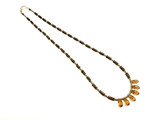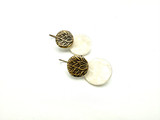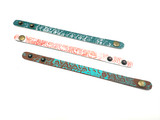About African Trade Beads
We carry an eclectic (and diminishing) variety of African beads, both old trade beads, and newer beads made or strung in Africa for the world-wide bead trade. Trade beads are old and/or used beads, and will show varying amounts of wear. Newly-made African beads are generally handmade in small communities. Style and availability vary.
Rings & Things founder, Russ Nobbs, loved trade beads and African Art. For many decades, he purchased trade beads from African traders -- for sale as well as for his personal collection. Since he passed away, we have slowed down on our trade bead purchasing, but we continue to research the beads he stashed away, and we periodically are able to add another batch of cool vintage beads from his personal collection to our website. Plus we can't resist an occasional purchase of Christmas beads, pretty colors of recycled glass beads, or other fun finds.
The chevron, or "rosetta," bead originated in Venice and became widely popular as a trade bead (used as currency) in Africa for centuries. Chevrons are created by building up several consecutive layers of color, and then grinding down the edges. The grinding exposes various layers of color, typically revealing a star (or "rosetta") pattern. Red, white and blue is the most typical color combination found in old chevrons, and this was the color combination most prevalently traded in West Africa. Even though the technology to make Venetian-style layered-glass chevrons did not exist in most of Africa until recently, the style gained such popularity that African-made beads of clay, bone and other materials were (and still are) sometimes painted or stained with chevron ("V"-shaped) designs.
Kiffa beads (sometimes called "saliva beads") are recycled-glass beads that reportedly have been made in the African country of Mauritania for 1,000 years! Mauritanian women are the typical creators of these festive ornaments. An intricately crafted form of recycled glass beads, these kiffas are true treasures! First, the beadmaker grinds available glass objects into a fine powder. Then, she creates a core shape by using saliva to mold glass powder around a stick (the stick creates the bead hole). Intricate, colored designs are then added to the surface of the core shape, again using saliva to hold the powdered glass together. Finally, the beads are placed on a potsherd, covered and fired on a bed of charcoal. Because Kiffa beads achieve such intricate designs using very basic tools and materials, they have been hailed as an example of the highest level of beadmaking skill and ingenuity.
Millefiori beads: Mosaic glasswork techniques have been used for centuries to create intricate glass beads, pendants and paperweights. One of the most popular mosaic varieties is called "thousand (mille) flowers (fiori)" -- in fact, many people now use the terms "mosaic" and "millefiori" interchangeably. Millefiori glass designs are created by making patterned canes from glass rods, slicing the resultant canes to reveal the patterned cross-section, and arranging these slices into mosaic patterns. The slices are often flower designs, hence the mosaic patterns created by fusing numerous slices have come to be called "thousand flowers" glasswork.
The majority of the millefiori, mosaic and trailed glass beads on our website are old, made in Venice in the 1800's and early 1900's, then sold or traded in Africa, and then brought to the United States by African traders in the late 1900's and early 2000's.
Skunk and Eye beads: At the time that we're writing this, we still have a few lovely old strands of red & white, and black & white, eye beads. Some have multicolored eyes. In recent decades, prices for these beads have skyrocketed, so when these are gone, we do not expect to be able to restock them for reasonable prices.
Krobo and powder glass beads: The technique of making powder glass and other recycled-glass beads by hand has been used in Africa for centuries. First, molds are created out of clay. Glass is chosen by color and crushed by hand into a material called the "fritt." For recycled glass beads, the glass isn't always crushed completely into a powder. The molds are often dipped in water and treated with kaolin clay to prevent sticking. A cassava stalk is often placed in the center of each mold and the rest of the mold is filled in with the "fritt." When fired, the stalks burn away leaving a hole in each bead. The molds are baked in a kiln hot enough to make the glass fuse together. From experience the beadmakers know how long to fire the molds, and can judge the temperature by the color of the flame. After firing the molds are removed. The beadmaker uses an awl in one hand while moving the mold with the other hand, spinning the gather of glass around to shape it. They then flip it over to shape the other side. Shaping and polishing is also done on a stone using sand and water. Beads are sometimes oiled to bring out their natural shine. Finally, it's off to the market.
Corner-cut blues (aka "Russian Blues"): These beautiful blue beads cause a lot of debate on the internet. They are faceted glass beads made in the early 1800's in Europe (Venice and possibly also Bohemia, which is now part of the Czech Republish), and then traded to either Africa or North America. Although Rings & Things is located in the Pacific Northwest of the U.S., our corner-cut blues came to us via the African bead trade, not the Alaskan, Canadian or "Russian" fur trade.
Dutch blues and Padre beads: Dutch / Dogon Beads from Rings & Things include classic large round Dutch blues as well as smaller white and clear wound beads in a donut or discoidal shape. Many of these were made in the Dutch Netherlands during the 1600's to 1800's. Our Padre beads likely have a variety of origins, and are often strung with brass bells or other African brass pendants. The brass pendants generally are made in Africa, and can be new or old.
Masai Glass Spacers and Goomba beads: These are white to off-white glass or porcelain beads. The larger beads are usually in a tile-bead shape, and the smaller beads are often in a more-rounded shape like a large seed bead. In the past, most of these white and off-white beads were Masai spacers from Kenya, but more recently, they've been coming to us from Ghana-based traders. Masai glass spacer beads are collected in Kenya or Tanzania (on the East coast of Africa). When they are collected in or near Nigeria (on the West coast of Africa) instead, they are called Gumba, Goomba or Goombah beads. These beads were generally made in Europe and traded to Africa in the early 1900's. Depending on where they ended up, they are called either Masai spacers, or Goomba beads. They are wonderful, slightly neutral, earthly-looking beads that are great accents and spacers for earrings, necklaces and bracelets.
Recycled-glass African beads: Recycled glass beads, like their name implies, are made of any type of locally-sourced glass that can be easily melted and turned into glass beads. We've heard that they're made of broken windows or soda bottles, but to be honest, we have no idea what they are actually recycled from. Multicolored recycled glass beads are sometimes called "end of day" beads, as they are simply made from the remaining colors still in the workspace when it's time to clean up at the end of the day. Whatever their source, we have a soft spot for just about anything that has a recycled content.
White Heart Trade Beads: The name "white heart" beads can be confusing since these beads are neither white nor heart shaped. The name comes from the white centers of these glass beads, which add an internal glow to the colored glass surrounding them. Another name for these beads is "Cornaline d' Allepo," which translates to "Carnelian of Allepo" or "Agate of Allepo." People in inter-tropical and temperate regions are said to have traditionally worn white heart beads (as well as carnelian and other agates) as a talisman to ward off disease.
The majority of our small white heart beads are newly produced in the Czech Republic. A few strands are imported from other European countries, or from Africa. You will also find a few old white heart bead strands, perfect for the collector of genuine historic beads.
Our Bead Blog
-
Edgy Elegance Necklace
Mar 22nd 2024Created by: Guest Designer Deb FlorosSuggested Supplies 1 #20-111-204 TOHO Glass Seed Bead, Size 11
-
Elegant Button Earrings
Mar 22nd 2024Created by: Guest Designer Deb FlorosSuggested Supplies 1 #27-841-042-50 Beadalon Bead Bumper, 1.5m
-
Abstract Painted Cuffs
Feb 26th 2024Created by: Guest Designer Deb FlorosSuggested Supplies 1 #51-810-05-17 Leather Cuff Bracelet, 1/2"



